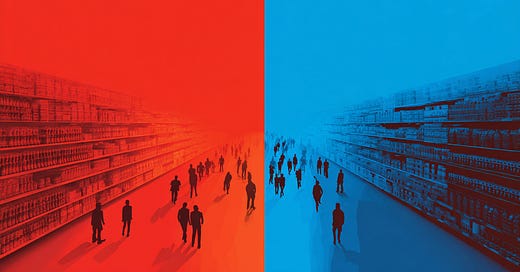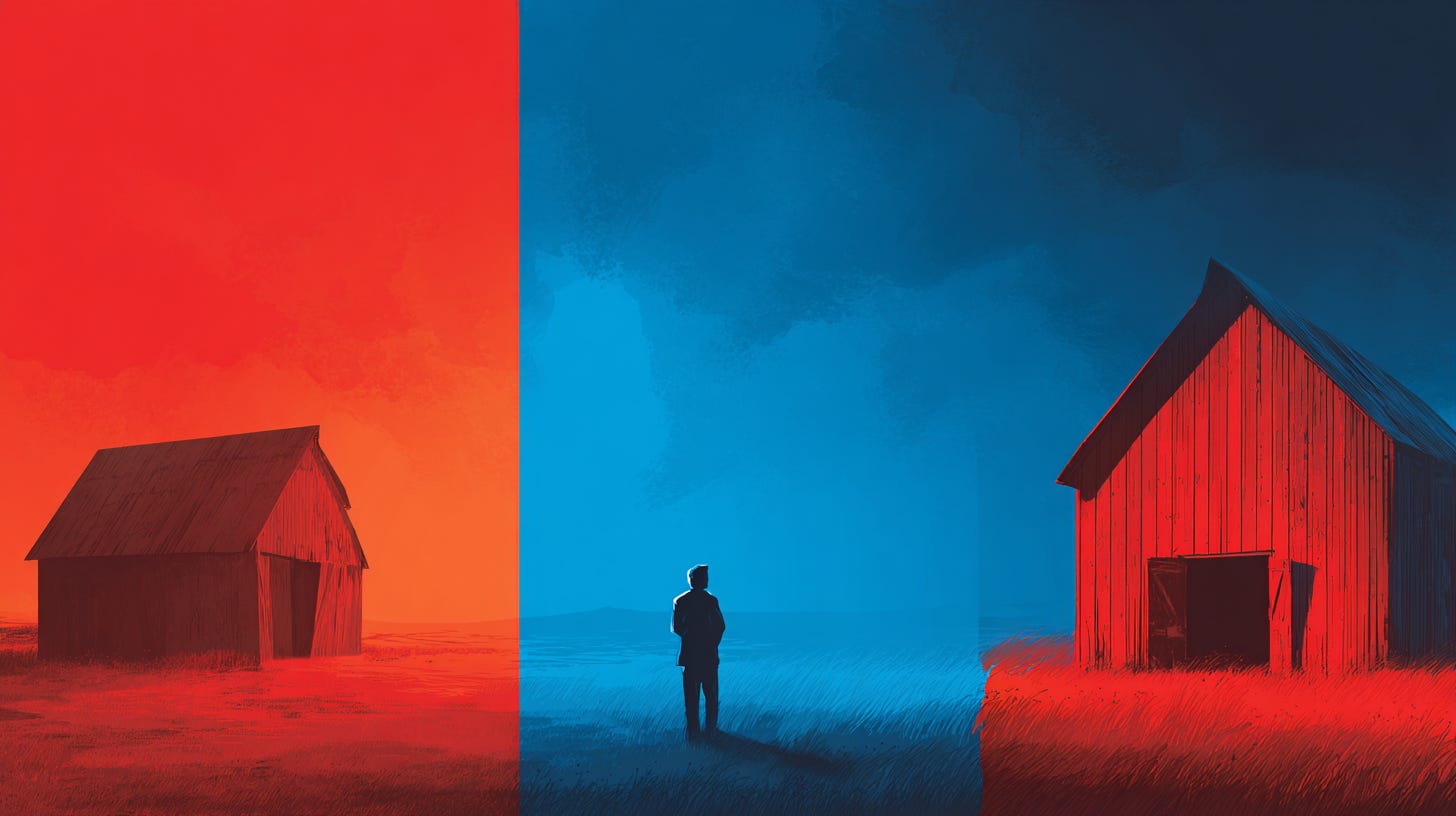From Political Tribes to Food Tribes
How America's dietary landscape mirrors our fractured political tribes
The collapse of shared consensus in American politics didn't happen overnight, but when it did collapse, it shattered completely. We went from a handful of television networks and newspapers serving as our collective truth-tellers to a fractured landscape where every political impulse, no matter how fringe, could find its audience and build its army.
This transformation represents more than partisan bickering—it's a fundamental shift in how we organize knowledge and community. The gatekeepers are gone. The center cannot hold because there is no longer a shared center to hold.
And this doesn't just end with politics. The same forces that reshaped how Americans think about food have created an explosion of dietary tribes that would have been incomprehensible just a generation ago. The question now is if we continue to fracture into ever smaller food tribes or congeal back into a more monolithic dietary ideology over the coming decades.
The Gatekeepers Fall
The pre-internet era operated on what scholars politely call "manufactured consent"—a handful of editors and broadcasters deciding what constituted legitimate discourse. Fringe ideas stayed fringe because they lacked infrastructure. You needed a printing press, a broadcast license, or at minimum, serious money to reach mass audiences.
The internet obliterated this overnight. Suddenly, anyone with a Twitter account or YouTube channel could bypass traditional media gatekeepers entirely. The cost of publishing dropped to zero. The barrier to entry disappeared. The long tail of political thought found its voice.
This democratization created space for previously marginalized perspectives, but it also unleashed conspiracy theories, extremist ideologies, and tribal thinking that prizes ideological purity over pragmatic solutions. Frictionless mass communication is a double-edged sword where ideas of enlightenment and ignorance can thrive.
Americans began sorting themselves into ever-smaller, ever-more-passionate tribes. These groups don't just disagree on policy—they frequently inhabit entirely different information ecosystems, complete with their own facts, heroes, and villains.
The result? A political landscape where the center cannot hold because there is no longer a shared center to hold.
Welcome to the Food Wars
This same dynamic is now playing out in American food culture, and the stakes may be higher. Food is intimate. It's about what we put in our bodies, how we nourish our children, what connects us to culture and memory. A generation ago, American eating patterns were remarkably uniform—meat, potatoes, vegetables, and processed foods from major brands. Deviation marked you as foreign, pretentious, or eccentric.
Today? The American food landscape has exploded into thousands of micro-tribes. Carnivores eating only meat. Raw vegans consuming nothing cooked. Ketogenic dieters shunning carbohydrates. Intermittent fasters restricting when they eat. Breatharians claiming to survive on air alone.
Each group has its own scientific studies, success stories, and explanations for why every other approach is dangerous. Each has found its community online, complete with influencers, brands, and commercial ecosystems. Walk through any Whole Foods and witness the tribalization in action—products for paleo dieters, FODMAP avoiders, biohackers, and dozens of dairy alternatives for various forms of avoidance.
The natural products industry exemplifies this shift. What was once a small health food store niche has become a multi-billion-dollar ecosystem serving every conceivable dietary philosophy. Thousands of entrepreneurs have built businesses around these niche communities, creating products that previous generations would find incomprehensible.
The MAGA-fication of Food?
The parallels between political and food tribalism are striking. MAGA quite literally led to MAHA. Both feature charismatic leaders promising simple solutions to complex problems. Both exhibit intense in-group loyalty and out-group hostility. Both tend toward ever-increasing radicalization as tribes compete for attention and purity.
In politics, this dynamic produced Trump—a figure who disrupted the established order by speaking directly to tribes that felt ignored by traditional gatekeepers. His rise came from bypassing traditional media and connecting with followers who felt abandoned by the political establishment. His success didn't come from building bridges but from burning them, not from seeking consensus but from exploiting division.
The food world may be entering its own Trump moment. The established nutritional order—government dietary guidelines, mainstream medical advice, big food companies—has lost credibility with large segments of the population. People are suspicious of official recommendations, skeptical of corporate messaging, and hungry for alternatives. The line between healthy skepticism and rigid dogma has blurred.
The question is whether this disruption will improve our food system or simply amplify our divisions.
The Disruption We Need (And the Destruction We Don't)
The current food system deserves disruption. Industrial agriculture has created environmental problems. Processed foods have contributed to obesity and chronic disease. The medical establishment has been slow to acknowledge diet's role in health. The diversity of food tribes represents a genuine search for better ways of eating and living.
But the political parallel suggests caution. While Trump's disruption energized his base, it also coarsened discourse, spread misinformation, deepened divisions, and hurt people. A Trump-like figure in food—someone promising simple solutions while attacking established institutions—might capture attention and followers, but the long-term consequences could be harmful.
We need disruptive leadership that challenges the status quo without resorting to demagoguery or anti-intellectualism. Leaders who can critique existing systems while maintaining respect for scientific method. Who can build communities without demonizing outsiders. Who can offer alternatives without claiming to have all the answers.
The Cost of Plurality
The proliferation of food tribes has undeniable benefits. It creates communities for people with specific health needs. It drives innovation in food production. It challenges complacent institutions. The explosion of dietary options means more people can find ways of eating that work for their bodies, beliefs, and lifestyles.
But this diversity comes with costs. The same information environment that enables legitimate dietary exploration also platforms charlatans, supplement hawkers, and dangerous extremists. For every evidence-based nutrition researcher building an online following, there's a wellness influencer promoting untested supplements or dangerous eating restrictions.
The democratization of nutrition advice has made it harder, not easier, for ordinary people to figure out what to eat. This raises a fundamental question: Is the presence of fringe voices and bad actors simply the price we pay for a diverse marketplace of ideas? Or can we preserve the benefits of dietary diversity while protecting people from harmful extremes?
Finding Balance in the Chaos
The answer lies in developing better mechanisms for evaluating and sharing information rather than trying to eliminate diversity itself. We need systems that can distinguish between legitimate dietary innovations and dangerous quackery. Between helpful communities and exploitative cults. Between beneficial disruption and destructive chaos.
This means investing in scientific literacy. Supporting independent research. Creating institutions that can adapt to new information while maintaining rigorous standards. Fostering a culture that values both open-mindedness and critical thinking—one that welcomes new ideas while maintaining healthy skepticism.
Just as in politics, we are addicted to simple stories about food. Industrial bad, local good. Processed evil, whole foods virtuous. Vegan enlightened, carnivore sinful. These binaries feel satisfying—they give us teams to join, enemies to fight, and the comforting illusion that we have figured it all out.
But our hunger for oversimplification blinds us to reality. When we reduce food's messy, interconnected nature to stark opposites, we lose the opportunity to understand the forces truly shaping what and how we eat.
The Scale of Change
The splintering of American food culture reflects something deeper than personal preference—it mirrors the fundamental reshaping of how humans organize themselves in the digital age. We are witnessing the democratization of expertise, the collapse of institutional authority, and the emergence of new forms of social organization that prioritize passion over credentials.
The question is whether this fragmentation will continue indefinitely or if some future shock—economic collapse, environmental crisis, or social upheaval—might force us back toward more unified food practices. While the infrastructure for niche communities seems permanent, history shows that dramatic circumstances can reshape even seemingly entrenched cultural patterns. The real question is what kind of food culture we're building for whatever comes next.
Beyond Individual Choice
The focus on personal dietary decisions obscures larger systemic changes that no individual can address alone. Climate change will reshape what we can grow and where. Technological advances will create entirely new categories of food. These macro forces suggest that the future of food will be determined less by which dietary philosophy wins and more by how well we can adapt our systems to changing conditions.
This requires moving beyond the language of conversion—where the goal is to get everyone to eat the same way—toward a language of coordination, where different dietary approaches can coexist within the same food system.
Living with Uncertainty
The proliferation of food tribes ultimately reflects our discomfort with uncertainty in an increasingly complex world. Each tribe offers the comfort of clarity, the relief of having figured it out, the satisfaction of belonging to something larger than ourselves.
But uncertainty isn't a problem to be solved—it's a condition to be navigated. The food system will continue evolving in ways we can't predict or control. The tribes that thrive will be those that can adapt without losing their core identity, that can maintain conviction without sacrificing curiosity.
The answer will shape not just what Americans eat, but how we organize knowledge and make collective decisions in an age when anyone can be an expert and everyone has a platform. In food, as in so many other domains, we are learning to live with plurality as a permanent condition rather than a temporary problem. How well we do may determine not just the health of our bodies, but the health of our democracy itself.
—
Want more?
My Book - Mise: On the Future of Food
My Podcast - The Tomorrow Today Show
My Instagram - The Book of Mise
My Consultancy - Mise Futures








